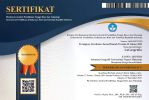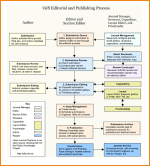Pemetaan Kondisi Ekologi Perkotaan Skala Mikro Menggunakan Citra Landsat 8 di Kota Semarang
(1) Universitas Muhammadiyah Surakarta
(2) Universitas Muhammadiyah Surakarta
(3) Universitas Muhammadiyah Surakarta
(4) Universitas Muhammadiyah Surakarta
(*) Corresponding Author
DOI: https://doi.org/10.35580/lageografia.v18i3.13476
Abstract
Semarang City, as a capital city of a province in Indonesia, has experienced intensive rural or suburban migration to urban robinareas. Consequently, the land surface temperature (LST) is getting warmer in urbanized areas and leading to microscale temperature variation from time to time. The objectives of this study are 1) to investigate the geographical distribution of LST and vegetation covers in Semarang, and 2) to map microscale urban ecological condition with regards to LST based on urban thermal field variance index (UTFVI). Landsat 8 data was utilized to derive LST as well as vegetation covers by means of normalized difference vegetation index (NDVI). Next, UTFVI was classified based LST. This study revealed that relatively low NDVI values which mainly consists of built up areas and grassland are predominantly concentrated in the northern and central parts of Semarang. High NDVI values representing vegetation covers are predominantly located in the southern portion of Semarang. The most ecologically depressed areas are mainly distributed in the central portions of the city toward the northern portions of coastal areas. Prioritized sub-districts to be ecologically restored are Ngaliyan, Semarang Utara and Semarang Barat. Upcoming studies should emphasize on finding suitable measures to restore ecologically stressed areas.
Keywords
Full Text:
PDFReferences
Gartland, L. (2011). Heat islands : understanding and mitigating heat in urban areas. London: Earthscan.
Guha, S., Govil, H., Dey, A., & Gill, N. (2018). Analytical study of land surface temperature with NDVI and NDBI using Landsat 8 OLI and TIRS data in Florence and Naples city, Italy. European Journal of Remote Sensing, 51(1), 667–678. doi: 10.1080/22797254.2018.1474494
Jensen, J. R. (2015). Introductory Digital Image Processing. Hoboken: Pearson Education.
Karnieli, A., Ohana-Levi, N., Silver, M., Paz-Kagan, T., Panov, N., Varghese, D., … Provenzale, A. (2019). Spatial and Seasonal Patterns in Vegetation Growth-Limiting Factors over Europe. Remote Sensing, 11(20), 2406. Retrieved from https://www.mdpi.com/2072-4292/11/20/2406
Lavrakas, P. J. (2008). Encyclopedia of Survey Research Methods. doi: 10.4135/9781412963947
Lillesand, T., Kiefer, R., & Chipman, J. (2004). Remote Sensing and Image Interpretation (Fifth Edition) (Vol. 146). doi: 10.2307/634969
Liou, Y.-A., Nguyen, A. K., & Li, M.-H. (2017). Assessing spatiotemporal eco-environmental vulnerability by Landsat data. Ecological Indicators, 80, 52–65. doi: https://doi.org/10.1016/j.ecolind.2017.04.055
Marfai, M. A., & King, L. (2007). Monitoring land subsidence in Semarang, Indonesia. Environmental Geology, 53(3), 651–659. doi: 10.1007/s00254-007-0680-3
Meng, X., Cheng, J., & Liang, S. (2017). Estimating Land Surface Temperature from Feng Yun-3C/MERSI Data Using a New Land Surface Emissivity Scheme. Remote Sensing, 9(12), 1247. Retrieved from https://www.mdpi.com/2072-4292/9/12/1247
Ndossi, M. I., & Avdan, U. (2016). Application of Open Source Coding Technologies in the Production of Land Surface Temperature (LST) Maps from Landsat: A PyQGIS Plugin. Remote Sensing, 8(5), 413. Retrieved from https://www.mdpi.com/2072-4292/8/5/413
Nugraha, S. B., Sidiq, W. A. B. N., & Hanafi, F. (2016). Landsat Image Analysis for Open Spaces Change Monitoring to Temperature Changes in Semarang City. Lst International Cohference on Geography and Education (ICGE 2016). doi: https://doi.org/10.2991/icge-16.2017.43
Ranagalage, M., Estoque, R. C., & Murayama, Y. (2017). An Urban Heat Island Study of the Colombo Metropolitan Area, Sri Lanka, Based on Landsat Data (1997–2017). ISPRS International Journal of Geo-Information, 6(7), 189. Retrieved from http://www.mdpi.com/2220-9964/6/7/189
Robinson, N. P., Allred, B. W., Jones, M. O., Moreno, A., Kimball, J. S., Naugle, D. E., … Richardson, A. D. (2017). A Dynamic Landsat Derived Normalized Difference Vegetation Index (NDVI) Product for the Conterminous United States. Remote Sensing, 9(8), 863. Retrieved from https://www.mdpi.com/2072-4292/9/8/863
Singh, P., Kikon, N., & Verma, P. (2017). Impact of land use change and urbanization on urban heat island in Lucknow city, Central India. A remote sensing based estimate. Sustainable Cities and Society, 32, 100–114. doi: https://doi.org/10.1016/j.scs.2017.02.018
United Nations. (2015). World Urbanization Prospects: The 2014 Revision: Highlights. New York: United Nations.
Wang, Y., Berardi, U., & Akbari, H. (2016). Comparing the effects of urban heat island mitigation strategies for Toronto, Canada. Energy and Buildings, 114, 2–19.
Wilonoyudho, S. (2014). Migrasi Dan Involusi Di Kota Semarang (Migration and Involution in Semarang City). Jurnal Manusia Dan Lingkungan, 21(1). doi: 10.22146/jml.18519
Zhang, J., Wang, Y., & Li, Y. (2006). A C++ program for retrieving land surface temperature from the data of Landsat TM/ETM+ band6. Computers & Geosciences, 32(10), 1796–1805. doi: https://doi.org/10.1016/j.cageo.2006.05.001
Article Metrics
Abstract view : 881 times | PDF view : 370 timesRefbacks
- There are currently no refbacks.
Copyright (c) 2020 Hamim Zaky Hadibasyir, Vidya Nahdhiyatul Fikriyah, M Iqbal Taufiqurrahman Sunariya, Danardono Danardono

This work is licensed under a Creative Commons Attribution-NonCommercial 4.0 International License.
LaGeografia: Jurnal Program Studi Pendidikan Geografi, Jurusan Geografi, Fakultas MIPA, Universitas Negeri Makassar.
Email: lageografia@unm.ac.id | +6285298749260
Editorial Office














































